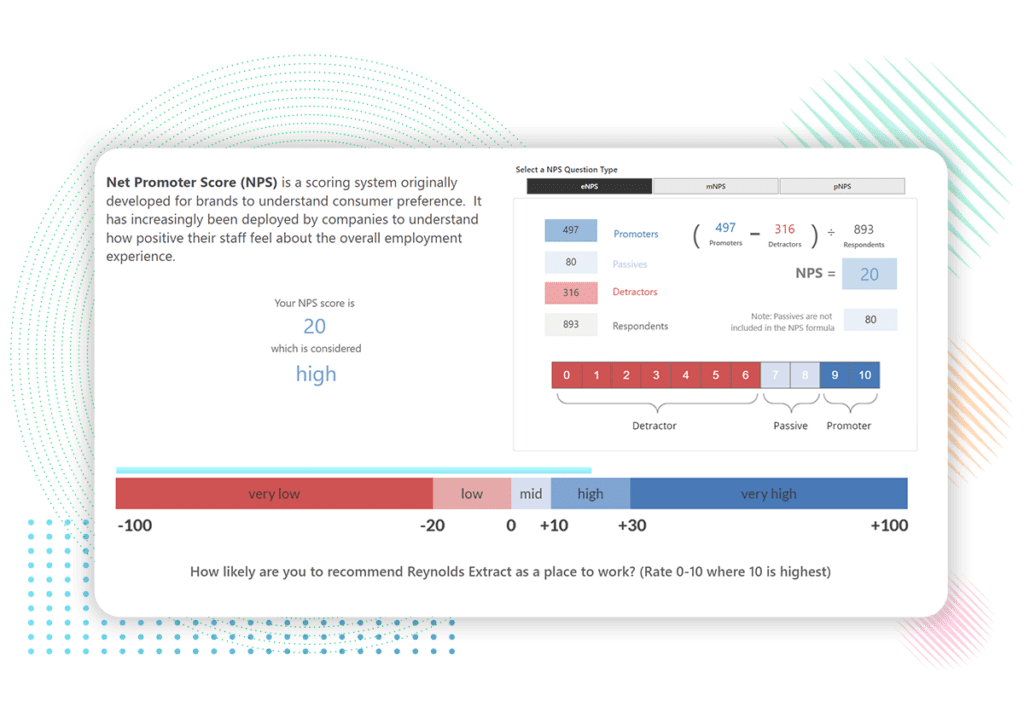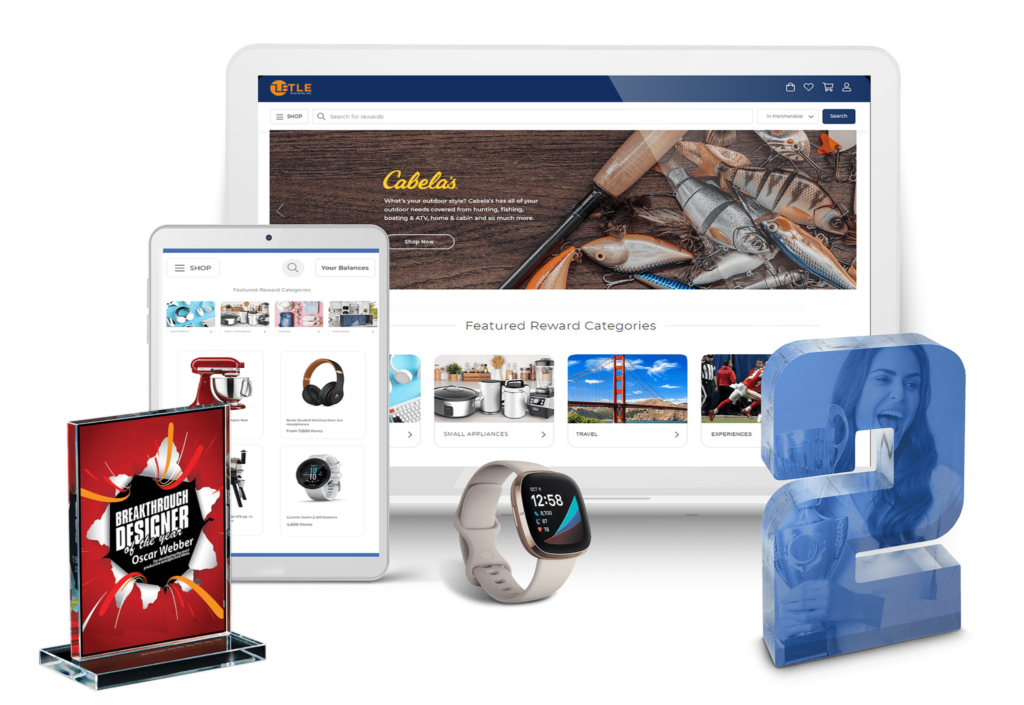November 13, 2023

Do you know how your employees feel about their work? If not, you could be missing out on some valuable insights.
An employee engagement survey is a great way to get feedback from your team and see how engaged they are with their work.
By asking the right questions, you can learn what motivates your employees and what makes them happy (or unhappy) at work.
Employee engagement surveys can help you identify problems early on before they become bigger issues.
However, before you dive into an employee survey, it's important to understand what they entail, the best questions to ask, and how to use the feedback to benefit your team. But first, what is employee engagement?
Employee Engagement Defined
Employee engagement is a measure of how connected employees are to their work and their company.
Engaged employees are passionate about their work and feel a sense of ownership over their projects. They're also more likely to be committed to the company's success and stay with the organization for the long haul.
So, it's no surprise that companies with high employee engagement rates also tend to outperform their competitors.
Focusing on engagement levels can help you attract and retain top talent, boost productivity, and create a positive work environment.
What is an Employee Engagement Survey?
An employee engagement survey is a tool that can be used for measuring employee engagement as well as how employees might feel about their work, their job satisfaction, and their commitment to the organization.
These surveys usually include questions about:
- Job satisfaction
- Employee engagement with work
- Commitment to the organization
- Motivation at work
- Satisfaction with management
An employee engagement survey can be administered in many different ways, but most are either paper-based or online.
They can be given to employees all at once (such as during a company-wide meeting), or they can be sent out periodically (such as once a year).
As the world continues to move to a more digital-first approach toward work, understanding how to keep employees engaged even when they work from home is key.
Additionally, some companies choose to make their employee surveys anonymous, while others allow employees to put their names on the survey.
Depending on your needs, you may or may not choose to utilize anonymous surveys.
Employee Engagement Survey Software
An employee engagement survey solution, like Terryberry's Be Heard platform, provides a simple solution for both employee engagement and pulse surveys.
Employee engagement survey software can range from basic and limited to robust and complicated. Choosing the right solution for your company will require leaders to analyze the specific needs of the organization.
Regardless, most companies will likely need a few broad features in their survey solution. These include:
- Easy-to-use survey design
- Custom or templated survey options
- Actionable analytics and dashboards
- Integrations with your company's HRIS
- The ability to send anonymous and non-anonymous surveys
Employee Engagement Today
Research from Gallup found that nearly 85% of people are either disengaged or actively disengaged at work.
With such a staggering number of disengaged employees, it's no wonder why more and more companies are be starting to rethink the entire employee experience.
Determining why they are disengaged is what will ultimately help shift tides to a happier workforce. That's where an employee engagement survey strategy can help.
These surveys have been around for years, but they've become increasingly popular in recent years. And it's no wonder why.
Employee engagement surveys provide valuable insights into how team members feel about their work. When done right, surveys can help organizations improve communication, increase job satisfaction, and boost productivity.
Furthermore, companies with a highly engaged team are 21% more productive and 22% more profitable than a disengaged team.
Conversely, poorly executed employee engagement surveys can do more harm than good. If not done correctly, they can create feelings of mistrust and resentment among employees.
With only 15% of the workforce feeling engaged, improving team morale and engagement should be a priority amongst all business leaders.
And because employee disengagement impacts business performance, retention, and team culture, it's essential that companies address any issues that have an impact.

Benefits of an Employee Engagement Survey Strategy
Employee engagement surveys are valuable tools for organizations to assess and improve the level of employee engagement and satisfaction among their employees. Here are some key benefits of conducting employee engagement surveys:
Identifying Areas for Improvement:
Surveys provide a structured way to gather feedback from employees about various aspects of their work environment, such as leadership, communication, workload, and work-life balance. This helps organizations pinpoint specific areas that need improvement.
Measuring Employee Satisfaction:
Surveys allow organizations to measure overall employee satisfaction and identify trends over time. Understanding the factors that contribute to satisfaction can help companies create a positive work environment.
Enhancing Communication:
Surveys provide a channel for employees to express their thoughts and concerns. This two-way communication fosters a culture of openness and transparency, making people feel heard and valued.
Boosting Employee Morale:
Knowing that their opinions matter and that the organization is actively seeking feedback can boost employee morale. This, in turn, contributes to a more positive and productive work environment.

Increasing Employee Retention:
Organizations can use survey data to identify factors that may contribute to employee turnover. By addressing these issues, companies can improve retention rates and reduce the costs associated with recruitment and training.
Driving Employee Engagement:
Engaged employees are more likely to be committed, motivated, and productive. Surveys help organizations understand the drivers of engagement, allowing them to implement strategies to enhance it, ultimately leading to more engaged employees over time.
Identifying Training Needs:
An engagement survey can highlight areas where employees would like additional training or development opportunities. This information is valuable for planning targeted training programs to improve skills and knowledge.
Aligning with Organizational Goals:
Employee engagement surveys can assess how well employees understand and align with the organization's mission, vision, and values. This alignment is crucial for achieving overall organizational goals.
Promoting a Culture of Continuous Improvement:
Conducting regular surveys establishes a culture of continuous improvement. Organizations can use the feedback received to make ongoing adjustments and demonstrate their commitment to creating a positive workplace.
Demonstrating Commitment to Employee Well-being:
The mere act of conducting engagement surveys signals to employees that their well-being and satisfaction are priorities for the organization. This can enhance trust, loyalty, and employee performance among the workforce.
It's important for organizations to not only conduct surveys but also to act on the feedback received, communicating the changes made as a result of the survey.
This demonstrates a genuine commitment to improvement and can further strengthen the employer-employee relationship.

What Questions Should You Include in Your Employee Engagement Survey?
Designing an effective employee engagement survey involves including a diverse set of topics that cover a range of aspects of the work environment.
The goal is to gather comprehensive feedback that can inform strategies to enhance employee engagement.
Here are some key topics to consider including in an employee engagement survey:
Overall Job Satisfaction:
Assess general employee satisfaction levels with the job, role, and the work environment.
Work-Life Balance:
Explore perceptions of work-life balance and whether employees feel they can manage their professional and personal lives effectively.
Communication and Feedback:
Evaluate the effectiveness of communication channels and the frequency and quality of feedback from supervisors and colleagues.
Leadership and Management:
Assess perceptions of leadership effectiveness in both middle and senior management, including communication skills, decision-making, and the ability to inspire and motivate teams.
Team Dynamics:
Explore how well teams collaborate, communicate, and support each other.
Career Development Opportunities:
Gauge employees' perceptions of opportunities for career advancement and professional development within the organization.
Recognition and Rewards:
Assess the effectiveness of recognition programs and the perceived fairness of rewards and compensation.
Training and Learning Opportunities:
Determine whether employees feel they have access to the training and learning opportunities needed to excel in their roles.
Company Culture:
Explore the alignment of employees with the organization's values, mission, and vision.
Job Clarity and Role Alignment:
Evaluate whether employees have a clear understanding of their roles, responsibilities, and how their work contributes to organizational goals.
Inclusion and Diversity:
Assess perceptions of diversity and inclusion within the workplace.
RELATED: DEI Initiatives: What They Are, Examples, & Tips for Implementing
Well-being and Health Programs:
Explore the availability and effectiveness of programs promoting employee well-being and health.
Employee Recognition and Appreciation:
Assess whether employees feel recognized and appreciated for their contributions.
Employee Engagement and Motivation:
Measuring employee engagement can be done both directly and indirectly. Asking a well-rounded set of questions will help paint a picture of how engaged your employees are, but you can always ask them directly how engaged they feel.
Job Resources and Tools:
Evaluate the adequacy and effectiveness of resources and tools provided to employees to perform their jobs.
Organizational Change and Communication:
Assess perceptions of how well the organization manages and communicates during periods of change.

Job Security and Satisfaction with Benefits:
Explore employees' perceptions of job security and satisfaction with the benefits offered.
Workplace Environment:
Evaluate the physical and cultural aspects of the workplace environment.
When designing your employee engagement survey questions, it's important to balance the depth of questions with the need for brevity to encourage high response rates. Additionally, consider including open-ended questions to allow employees to provide more detailed feedback and insights.
Regularly reviewing and updating the survey based on evolving organizational needs and feedback from employees can ensure its continued effectiveness and increased employee engagement over time.
Examples of Employee Engagement Survey Questions
Crafting effective employee engagement survey questions is crucial for being able to measure employee engagement.
Here's a selection of sample questions across various categories:
1. Job Satisfaction:
How satisfied are you with your current role and responsibilities?
To what extent does your job align with your skills and interests?
On a scale of 1 to 10, how happy are you at work?
2. Work-Life Balance:
Do you feel you have a good work-life balance?
How often do you find yourself working outside of regular business hours?
Are you able to take advantage of flexible work arrangements?

3. Communication and Feedback:
How satisfied are you with the communication channels within the organization?
How frequently do you receive constructive feedback on your performance?
Do you feel your opinions and ideas are valued and acknowledged?
4. Leadership and Management:
How confident are you in the leadership team's ability to guide the organization?
To what extent do you feel supported by your immediate supervisor?
How effective is leadership in fostering a positive work culture?
5. Team Dynamics:
How well does your team collaborate on projects and tasks?
Do you feel a sense of camaraderie and teamwork within your department?
Are team goals and objectives clearly communicated?
6. Career Development:
How satisfied are you with the opportunities for career advancement within the organization?
Do you feel you have access to the training and development resources needed to excel in your role?
Are there clear paths for career growth in your department?
7. Recognition and Rewards:
How satisfied are you with the recognition and rewards programs in place?
Do you feel your efforts and contributions are adequately acknowledged?
Are you satisfied with the fairness of compensation and benefits?
8. Organizational Culture:
How well do the organization's values align with your personal values?
To what extent do you feel a sense of belonging to the organization's culture?
How would you describe the overall workplace culture?
9. Inclusion and Diversity:
How inclusive do you find the workplace environment?
Do you believe diversity is valued and promoted within the organization?
How comfortable are you discussing diversity-related topics at work?
10. Employee Engagement and Motivation:
On a scale of 1 to 10, how engaged are you in your work?
What motivates you to perform at your best?
How well do you understand the impact of your work on the organization's success?
11. Job Resources and Tools:
Are you satisfied with the resources and tools provided to perform your job effectively?
Do you feel adequately equipped to meet the demands of your role?
Are there any specific tools or resources you believe would enhance your performance?
12. Workplace Environment:
How would you rate the physical work environment (e.g., office space, facilities)?
Does the workplace culture promote a sense of well-being?
How comfortable do you feel in sharing your opinions and ideas with colleagues?
Open-ended Questions:
What aspects of your job do you find most fulfilling?
What challenges do you face in your role, and how can they be addressed?
Is there anything else you would like to share about your experience at the company?
When using these questions, it's important to customize them based on the specific context and goals of your organization.
Additionally, consider a mix of scaled questions (e.g., Likert scale) and open-ended questions to gather both quantitative and qualitative data. Regularly updating and refining survey questions based on feedback and changing organizational needs is also recommended.
RELATED: 12 Employee Engagement Ideas
Should Your Employee Engagement Survey Be Anonymous?
Now that you know what an employee engagement survey is and what questions to ask, you may be wondering if you should make the survey anonymous.
While you may want to know exactly what each person on your team thinks so you can address any concerns, staying anonymous allows people to be more truthful with their opinions.
Either way, there are pros and cons to both anonymous and non-anonymous surveys.

Pros of Making the Survey Anonymous
If you make your survey anonymous, employees may feel more comfortable being honest, which can result in more accurate results. Anonymity can also help reduce any potential bias in the survey results.
Cons of Making the Survey Anonymous
If you make the survey anonymous, you won't be able to address any topics directly with employees. This can make it difficult to take action on the feedback you receive, both positive and negative.
For example, an employee may say they’re looking for advancement opportunities. Rather than being able to discuss this with the individual directly, you may need to address it company wide.
Conversely, if there’s an unhappy employee, it can be difficult to resolve the problem without knowing who specifically is upset.
It's important to weigh the options and decide what's best for your team. No matter what approach you take, employee engagement surveys can be very beneficial for companies of all sizes.
Utilizing Employee Engagement Survey Feedback
Once you've collected the employee engagement survey results, it's time now to take action on the employee feedback. This stage is arguably the most critical part of your engagement strategy.
Whether you decide to address concerns directly with employees or make changes to company policy, it's crucial that you address employee feedback in one form or another.
Doing so shows your team that their voices are being heard. Not only will this build trust, it will also encourage employees to take part in future surveys as well.
Employee engagement surveys can be a great way to gather feedback and improve your company culture. By asking the right questions and taking action on the results, companies can creative highly engaged employees.
Getting Started
Interested in learning more about how your company can benefit from improving your employee experience through engagement surveys? Schedule a demo of Terryberry's new Be Heard platform today.



